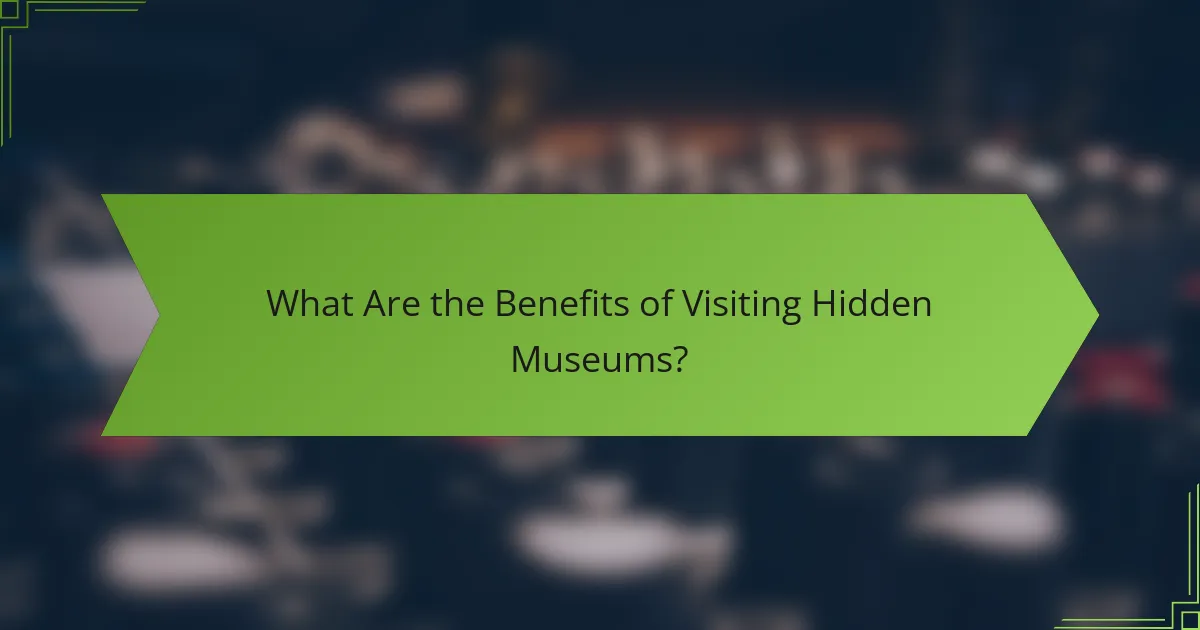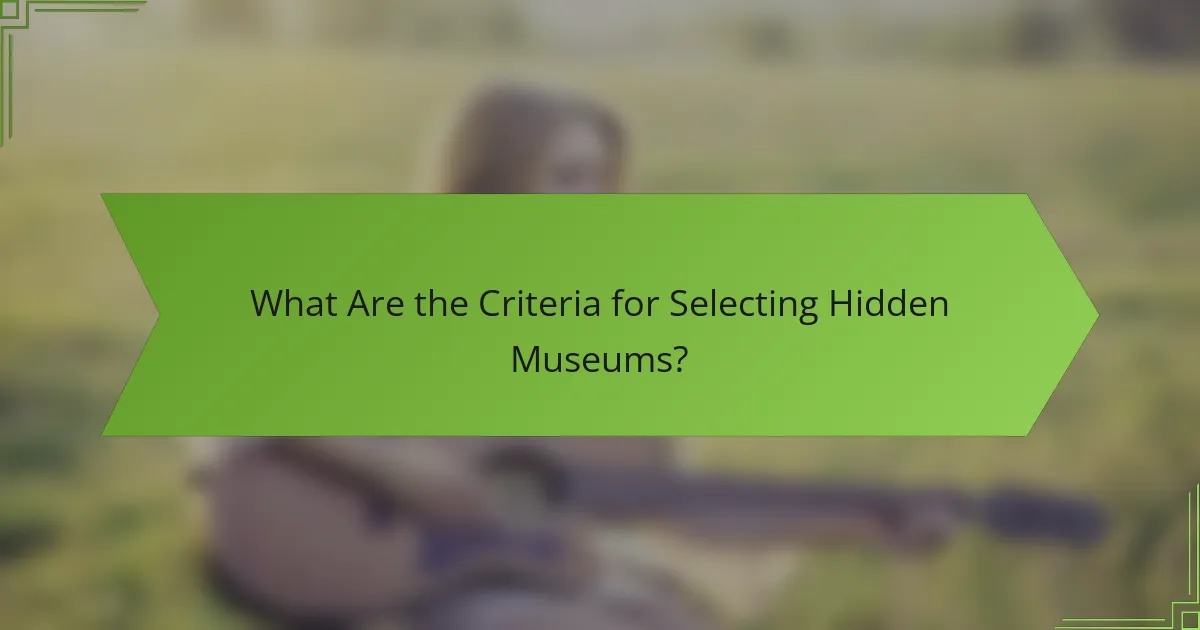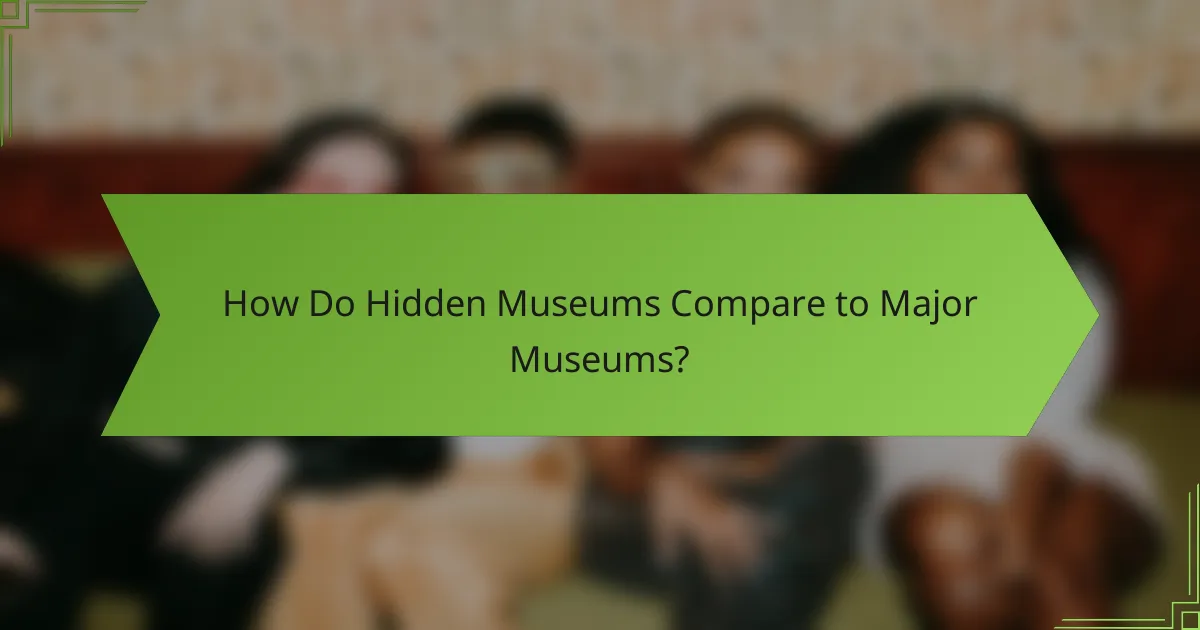Europe is home to several hidden museums that offer free admission, inviting visitors to discover unique collections and lesser-known art without any cost. These charming venues enhance your cultural experience, allowing for a more intimate exploration of history and creativity away from the crowded tourist attractions.

Which Hidden Museums Offer Free Admission in Europe?
Several hidden museums in Europe provide free admission, allowing visitors to explore unique collections without any cost. These museums often feature lesser-known art and artifacts, making them a delightful addition to any travel itinerary.
Musée d’Art Moderne de la Ville de Paris
The Musée d’Art Moderne de la Ville de Paris offers free entry to its permanent collections, showcasing a rich array of 20th-century art. Visitors can enjoy works by renowned artists such as Picasso and Braque without paying an admission fee.
Located near the Seine, this museum is an excellent spot for art enthusiasts looking to immerse themselves in modern art. Be sure to check the museum’s schedule for temporary exhibitions, which may have a fee.
National Gallery, London
The National Gallery in London provides free access to its extensive collection of Western European paintings, featuring masterpieces by Van Gogh, Monet, and Da Vinci. This makes it a must-visit for anyone interested in classic art.
While general admission is free, consider booking a guided tour for a more in-depth experience. The museum also offers special exhibitions that may require a ticket, so plan accordingly.
Berlinische Galerie, Berlin
Berlinische Galerie is a contemporary art museum that allows free entry on certain days, making it accessible for those exploring Berlin’s vibrant art scene. The museum focuses on modern art, photography, and architecture from Berlin.
Check their website for specific free admission days and times. It’s a great opportunity to discover local artists and innovative exhibitions without spending a euro.
Musée des Arts et Métiers, Paris
The Musée des Arts et Métiers in Paris features a fascinating collection of inventions and technological advancements, with free admission to its permanent exhibits. This museum is ideal for those interested in science and industrial history.
While the permanent collection is free, special exhibitions may have an entry fee. Plan your visit to ensure you can explore the various sections, including the history of aviation and robotics.
Palazzo Venier dei Leoni, Venice
Palazzo Venier dei Leoni, home to the Peggy Guggenheim Collection, offers free admission on specific days, allowing visitors to enjoy modern art in a stunning setting. The collection includes works by artists such as Pollock and Kandinsky.
To take advantage of free entry, check the museum’s calendar for designated days. This is a fantastic way to experience art in Venice without the usual costs associated with major attractions.

How to Find Free Admission Days for Museums in Europe?
To find free admission days for museums in Europe, start by checking official museum websites, using museum pass apps, and following local tourism boards. These resources provide up-to-date information on special events and free entry days, ensuring you don’t miss out on opportunities to explore cultural sites without spending money.
Check official museum websites
Most museums in Europe maintain their own websites, where they publish information about free admission days and special events. Look for sections dedicated to visitor information or events, as these often highlight any upcoming free entry opportunities.
Additionally, some museums may require advance booking for free days due to limited capacity. Always check the website for any specific requirements or restrictions to ensure a smooth visit.
Use museum pass apps
Museum pass apps can be a valuable tool for discovering free admission days. These apps often aggregate information from multiple museums, allowing you to see which ones offer free entry on specific dates. Popular apps include the “Museum Pass” and “City Pass” options, which may vary by country.
When using these apps, pay attention to user reviews and ratings to find the most reliable options. Some apps may also provide discounts or additional perks, enhancing your overall museum experience.
Follow local tourism boards
Local tourism boards are excellent resources for finding free admission days at museums. They often promote cultural events and special offers in the area, including free entry to museums. Visit their websites or social media pages for the latest updates and announcements.
Consider subscribing to newsletters from these boards to receive timely information about free museum days and other local attractions. This can help you plan your visits around these opportunities, maximizing your cultural experiences while minimizing costs.

What Are the Benefits of Visiting Hidden Museums?
Visiting hidden museums offers unique advantages that enhance your cultural experience while often being free of charge. These lesser-known venues provide an opportunity to engage with art and history in a more intimate setting, away from the mainstream tourist spots.
Unique cultural experiences
Hidden museums often showcase local art and artifacts that reflect the unique heritage of a region. Unlike larger institutions, these smaller venues may host rotating exhibits featuring local artists or themes that resonate with the community.
For example, a small museum in a quaint European town might focus on the area’s traditional crafts, providing visitors with a deeper understanding of local customs and practices. Engaging with these cultural narratives can be both enlightening and enriching.
Less crowded environments
One of the main benefits of hidden museums is the significantly reduced foot traffic compared to popular attractions. This allows for a more relaxed visit where you can take your time to appreciate the exhibits without feeling rushed or overwhelmed.
With fewer visitors, you can often enjoy a more personal interaction with the staff, who may be passionate about sharing their knowledge and insights. This intimate setting can lead to a more meaningful experience as you connect with the art and history on display.
Access to local history
Hidden museums frequently focus on the history of their specific locality, offering insights that larger institutions may overlook. These venues often preserve and present artifacts and stories that are integral to understanding the region’s past.
For instance, a hidden museum in Italy might feature exhibits on the local resistance during World War II, providing a perspective that is often absent from broader historical narratives. By visiting these museums, you gain a richer appreciation of the area’s heritage and its impact on contemporary culture.

What Are the Criteria for Selecting Hidden Museums?
Hidden museums are typically selected based on their accessibility, the variety of exhibits they offer, and their reputation as reflected in visitor reviews. These criteria help ensure that the museums provide a unique and enriching experience while remaining relatively undiscovered by the general public.
Location accessibility
Location accessibility refers to how easy it is for visitors to reach a museum. Museums that are well-connected by public transport or located in central areas tend to attract more visitors. Consider proximity to major cities or tourist attractions, as well as available parking options.
For instance, a hidden museum in a suburban area may be less accessible than one in a bustling city center. Check local transport schedules and routes to ensure a smooth visit.
Exhibit diversity
Exhibit diversity is crucial for attracting a wide range of visitors. Museums that showcase various art forms, historical artifacts, or interactive displays often provide a richer experience. Look for museums that rotate their exhibits or offer special collections to keep the experience fresh.
For example, a museum featuring both contemporary art and local history can appeal to different interests, making it a more attractive destination for families or groups.
Visitor reviews and ratings
Visitor reviews and ratings offer insights into the quality of a museum’s offerings. High ratings on platforms like TripAdvisor or Google Reviews can indicate a positive experience, while constructive feedback can highlight areas for improvement. Pay attention to comments about the staff, cleanliness, and overall atmosphere.
Checking recent reviews can also help gauge whether a museum remains engaging over time. Look for patterns in feedback to identify which hidden gems are worth exploring based on current visitor experiences.

How Do Hidden Museums Compare to Major Museums?
Hidden museums often provide a more intimate and unique experience compared to major museums, which can be crowded and commercialized. They typically focus on niche collections or local history, allowing visitors to engage more deeply with the exhibits.
Cost-effectiveness
Hidden museums frequently offer free or low-cost admission, making them an attractive option for budget-conscious travelers. While major museums may charge entry fees that can range from €10 to €20 or more, many lesser-known venues operate on donations or have suggested contributions.
This cost-effectiveness allows visitors to explore multiple hidden museums in a single day without significant financial strain. For example, a day spent visiting three hidden museums might only require a small donation of €5 total, compared to a single ticket at a major museum.
Personalized experiences
Hidden museums often provide personalized experiences that major museums may lack due to their size and visitor volume. Smaller venues typically have fewer visitors, allowing for more interaction with staff or curators who can offer insights and answer questions about the exhibits.
Additionally, many hidden museums focus on local culture and history, which can lead to a more meaningful connection with the exhibits. Visitors might find unique artifacts or art pieces that tell stories specific to the region, enhancing their overall experience.



